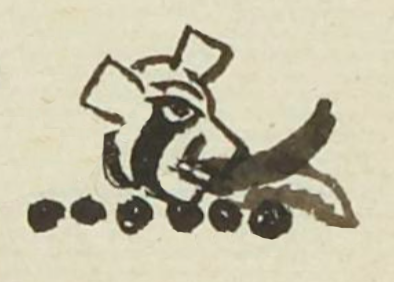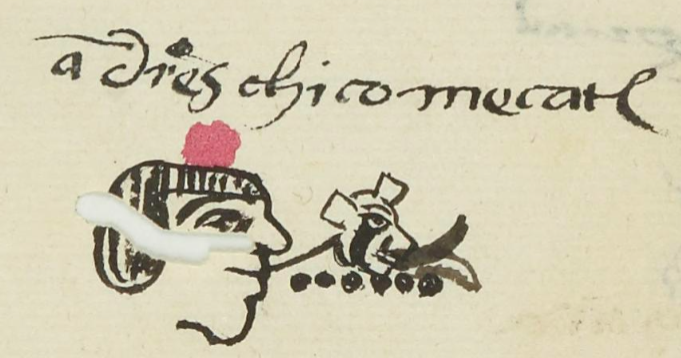Chicome Ecatl (MH606r)
This black-line drawing of the simplex glyph and notation for the personal name Chicome Ecatl or Chicome Ehecatl (“Seven Wind” or "7-Wind," attested here as a man’s name) shows the head of the divine force of the wind (Ehecatl) and, below that, six dots that are meant to show the number seven (chicome). The head of the divinity is shown in profile, facing toward the viewer's right. Its eye is open, its ears are squared off, and it has a curving stripe of face paint or tattoo on its cheek. Coming out of its mouth is a beak-like shape, black on the top half and white on the bottom half.
Stephanie Wood
This day sign comes from the tonalpohualli, the 260-day divinatory calendar. Calendrics figure importantly in Nahuas' religious views of the cosmos.
We know that this is a calendrical name given the numerical coefficient. The gloss says ecatl (air, breath) for the day sign, but scholars agree that the day sign should be ehecatl (wind). The Matrícula de Huexotzinco regularly gives ecatl for ehecatl, and we are preserving the spelling in this collection. That said, perhaps the division between air, breath, and wind is overwrought, and all translations to ecatl should read wind.
The tlacuilo's error in representing the number (six dots instead of seven) is not unusual. There are many such mistakes in the Matrícula de Huexotzinco. Were the tlacuilos forgetting how to write numbers in the style of the autonomous era?
Gabrielle Vail and Christine Hernández (Re-Creating Primordial Time, 2013, ) describe Ehecatl as the wind aspect of Quetzalcoatl, and they note that Ehecatl "wears a buccal (duck) mask through which to blow wind." That the "beak" may have been perceived as a blowing device is supported by the glyph for Pitztli (below).
Stephanie Wood
ādies chicomecatl
1560
Jeff Haskett-Wood
fechas, calendarios, números, siete, viento, aire, aliento, fuerza divina

chicome, seven, https://nahuatl.wired-humanities.org/content/chicome
eca(tl), air, breath, https://nahuatl.wired-humanities.org/content/ecatl
eheca(tl), wind, https://nahuatl.wired-humanities.org/content/ehecatl
Siete Viento, o 7-Viento
Stephanie Wood
Matrícula de Huexotzinco, folio 606r, World Digital Library, https://www.loc.gov/resource/gdcwdl.wdl_15282/?sp=294st=image.
This manuscript is hosted by the Library of Congress and the World Digital Library; used here with the Creative Commons, “Attribution-NonCommercial-ShareAlike 3.0 License” (CC-BY-NC-SAq 3.0).



